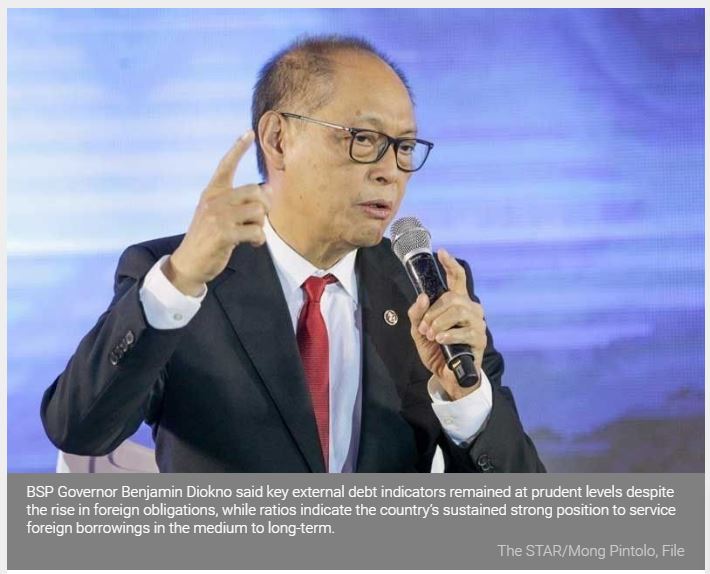Philippines: External debt up 8.2% to $82.7 billion in September
MANILA, Philippines — The country’s external debt increased by 8.2 percent to $82.7 billion as of end-September from $76.4 billion in the same period last year as the private sector, led by local banks, tapped the offshore debt market for much needed funds, according to the Bangko Sentral ng Pilipinas.
BSP Governor Benjamin Diokno said key external debt indicators remained at prudent levels despite the rise in foreign obligations, while ratios indicate the country’s sustained strong position to service foreign borrowings in the medium to long-term.
The debt service ratio, which measures the adequacy of the country’s foreign exchange earnings to meet maturing obligations, remained at single-digit level of 6.4 percent, while the external debt ratio, a solvency indicator, decreased further to 19.7 percent.
For the third quarter alone, the debt stock inched up by 1.7 percent compared to the $81.3 billion as of end-June due to net availments of $2.2 billion attributed to bond issuances of the national government and private local banks.
On the other hand, the increase in residents’ investments in Philippine debt papers issued offshore amounting to $426 million, negative foreign exchange revaluation of $211 million, and prior periods’ adjustments of $114 million partially offset the uptick in the debt stock.
According to BSP data, public sector external debt rose by 7.6 percent to $42.5 billion as of end-September from $39.5 billion a year ago and accounted for more than half or 51.4 percent of the country’s foreign debt.
Diokno said about $35.6 billion of public sector obligations were national government borrowings, while the remaining $7 billion pertained to loans of government-owned and controlled corporations, government financial institutions and the central bank.
Private sector debt went up by 8.9 percent year-on-year to $40.2 billion from $36.9 billion.
“The recorded rise in private sector borrowings may be attributed to bond issuances of private local banks, of which $401 million are ASEAN green bonds,” the BSP chief said.
According to the BSP, major creditor countries include Japan with $14.8 billion followed by the US with $4.3 billion, the United Kingdom with $3.6 billion, and the Netherlands with $3.1 billion.
Obligations to foreign banks and other financial institutions had the largest share at 32.6 percent of total outstanding debt, followed by loans from official sources with multilateral lending institutions with 17.7 percent and bilateral creditors with 13 percent.
Bilateral sources amounting to $10.7 billion were Japan with $7.9 billion, China with $705 million, and the Republic of Korea with $480 million, among others.
On the other hand, foreign holders of bonds and notes partake 29.5 percent; and the rest or 6.5 percent were owed to other creditor types, mainly suppliers and exporters.
In terms of currency mix, the country’s debt stock remained largely denominated in dollar with 59.2 percent and Japanese yen with13.8 percent. US dollar-denominated multi-currency loans from the World Bank and ADB represented 15.2 percent.
Data showed the maturity profile of the country’s external debt remained predominantly medium- and long-term in nature with original maturities longer than one year with share to total at 80.8 percent, while short-term accounts with maturities of up to one year comprised the 19.2 percent balance.
Source: https://www.philstar.com/business/2019/12/16/1977256/external-debt-82-827-billion-september#IWRtLGphwPTKAHtD.99


 English
English




